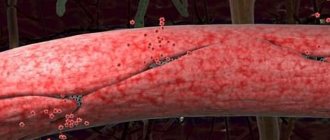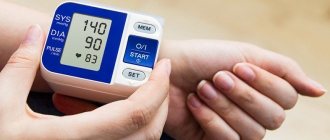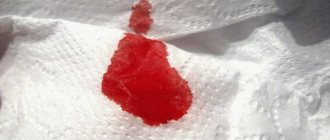The mucous membrane of the eye contains a large number of blood vessels, which can rupture under the influence of various factors. A bruise appears on the light conjunctiva, which can cause aesthetic discomfort and be a sign of certain pathologies. In order to find out why a vessel in the eye burst and what to do in this case, you need to visit an appropriate specialist - an ophthalmologist.
Why does a capillary burst?
- 6.1 Medicines in drops for ruptured eye capillaries
- 8.1 Video: How to remove red eyes: 10 home methods
Burst of a blood vessel in the eye
From time to time, capillaries burst in every person's eye. If it happens infrequently and is classified as an isolated incident, there is nothing to worry about. There can be many reasons for the rupture of a thin blood vessel, and they do not necessarily signal the presence of a serious pathological condition. But if the capillaries are damaged regularly, the damage covers a large area, the eyes are constantly red, they feel heaviness, pain or other atypical sensations, the cause of the capillary rupture may be serious and require treatment.
Red whites of eyes
Important! Every smallest detail is important in the functioning of the eye as an integral part of the visual apparatus. Even a minor malfunction can impair vision and even ultimately lead to blindness. Even a ruptured capillary, if it happens systematically, should be a reason to visit a doctor.
A capillary burst in the eye - what to do?
Why do blood vessels in the eyes rupture?
If the eye organ has been subjected to intense influence for a long period, then the vessels will inevitably burst. Working at a computer, reading in poor light, or handling small objects can lead to overwork.
- For example, a vessel may burst during jewelry work or the production of crushed elements. This condition is easy to treat with eye drops and rest;
- A blow can cause redness. This impact damages the capillaries and they burst;
- Another reason is related to serious illnesses. For example, myopia and astigmatism often manifest themselves in redness of the eyes. This occurs due to constant voltage. After all, vision weakens and the eye instinctively strains to examine distant objects;
- Redness as a symptom can be caused by a number of diseases. As a rule, they are associated with an infectious lesion. In this case, the infection can affect the conjunctiva or penetrate into the deeper organs of the eye. Thus, trachoma - inflammation of the lacrimal glands is always accompanied by severe redness when the protein changes color due to burst vessels. A very common disease is conjunctivitis. It is caused by debris that gets into the eye and occurs as a result of poor lens care. If you do not do daily cleaning, the accumulated infection will constantly lead to inflammation;
Thus, the reasons why one or two eyes become red are due to exposure to viruses, injury or the presence of serious pathologies. It is necessary to accurately determine the cause of redness and remove it through treatment. Simple exposure with drops will be sufficient only if it is caused by ordinary fatigue.
Return to contents
What it looks and feels like
The white of the eye changes color, turning red spotwise, partially or completely. In some cases, it literally becomes filled with blood, and sometimes only “rusty” spots or reddish streaks appear on the surface of the protein. All these are signs of a ruptured capillary, one or more. Usually the redness goes away on its own after three to five days, but if it does not go away or occurs again, a visit to an ophthalmologist is inevitable.
By the way. If the burst capillary is located in the visible part of the white, not covered by the eyelid, then the redness will be clearly visible, but if the rupture occurs in a segment that is not visible, the person may not notice microhemorrhages if he does not pay attention to the sudden heaviness and feeling of obstruction in the eye .
Bleeding in the eye
Many people do not feel when a capillary bursts. Others or a mirror can tell them that they have a red eye. But some people, even with a single damaged capillary, experience a headache, fever or chills, dizziness, and “floaters” appear in the eyes.
The fact that the eye becomes frighteningly red and looks unaesthetic is not scary. The danger arises not when the protein has already turned red, but at the moment the capillary ruptures. And, of course, the reasons that lead to a break can pose a danger.
Burst of a blood vessel in the eye
Classification
Let us analyze the classification according to the localization of the pathological symptom. A vessel can burst in different structures of the visual organ:
- If it bursts in the retina, then redness of the proteins is observed. A person notices a sharp deterioration in visual functions: vision is blurred, it is difficult to focus.
- Hemophthalmos is hemorrhage in the vitreous body. A protruding bump appears on the sclera. A person sees flickering spots and sparks. A dangerous complication is retinal detachment.
- Eye socket. Hemorrhage of this localization is typical for blood diseases and traumatic injuries to the visual organ. At the same time, the person notes that the eye is red, hurts when moving, protrudes forward, and many areas of hemorrhage appear.
- Hyphema is a blood clot in the anterior chamber. Shifts when the body position changes from horizontal to vertical.
List of reasons
A number of reasons why capillary damage occurs can be called internal or pathological, largely independent of the person.
- Changes from low to high, and vice versa, in blood pressure indicators.
- State of hypertensive crisis.
- Diabetes disease.
- Tumors located in the area of the visual apparatus.
- Various eye diseases.
Viral keratitis - A condition of capillaries in which their walls have increased fragility.
- Avitaminosis.
- Impact or injury causing concussion.
- Labor pains.
- Heavy alcohol intoxication.
- Physical fatigue or heavy lifting.
- Visual fatigue.
Visual fatigue has become the most common ophthalmic pathology in recent years. - Meteorological dependence.
As you can see, there are many reasons, and only an ophthalmologist can determine which of them caused the vascular network to break through. In addition to the above internal reasons, there are also external factors that can also cause capillary rupture:
- use of contact lenses;
- visiting the sauna;
- dry air in the apartment;
- cold;
- dust in the room;
- smoke in the room or atmosphere;
- wind, bright sunlight and other natural phenomena;
- penetration of a foreign body into the eye.
After the bath, the eyes fester and turn red
How to use eye drops correctly?
When carrying out therapy to strengthen the capillaries of the eye or hemorrhages, you need to follow a certain scheme:
- The procedure must be carried out only with clean hands using bactericidal soap.
- Before using drops, you need to check their expiration date. It can have a detrimental effect and cause complications.
- The lower eyelid of the eye needs to be pulled back, then pressed on the bottle, squeezing one or two drops of the drug out of it.
- Hold your eye open for two seconds, then you can close it and remove the medication with a napkin.
If a blood vessel bursts in a child, you need to find out from him what happened without panicking. It is not recommended to try to remove a foreign body yourself. It is necessary to apply an eye patch and consult a doctor.
In the future, the medical specialist determines the cause of the incident and carries out appropriate treatment.
Non-pathological causes and help
Even prolonged visual strain in the absence of rest for the eyes can put a strain on the capillaries beyond normal, which will lead to their rupture. Often the causes of microbleeds in the eye are, at first glance, ordinary actions and events that a person, as a rule, does not pay attention to.
By the way. Going to the sauna, drinking alcohol, hypothermia or overheating, being in the wind, carrying furniture, a quarrel accompanied by emotional screams and ending in tears - all this can help a capillary in the eye burst.
There are many non-pathological causes
- If you regularly do not get enough sleep, get plenty of rest, get enough sleep, try to go to bed earlier and sleep for at least eight hours, observing the conditions for quality sleep.
- Reduce the load in case of constant physical overexertion that has caused damage to the capillaries.
- Avoid stressful situations that cause increased emotionality.
- Rest your eyes more often during visual stress, do gymnastics, and take care of high-quality lighting.
- Do not abuse alcohol and quit smoking until the walls of the blood vessels are completely thinned.
- If your capillaries are weak, do not go to the bathhouse or sauna.
- Take vitamins that will make the walls of blood vessels more elastic and stronger.
Red whites of the eyes - what to do
By the way. If for some reason your capillaries have fragile walls, it is necessary to constantly prevent hemorrhages and not be in a situation in which the vessels may be damaged.
Video: Why blood vessels burst in the eyes
What to do if hemorrhages appear too often?
Constantly recurring hemorrhages require a complete examination of the body. The pathology is probably caused by somatic diseases, ophthalmological diseases, and lack of vitamins.
Having discovered reddened sclera, it is recommended to perform the following actions:
- Pay attention to your diet. It should be dominated by foods rich in vitamin C and rutin. There are many of them in citrus fruits, lettuce, bell peppers, and spinach.
- Colds are treated with antiviral drugs. They do not destroy small capillaries.
- Limit trips to the bathhouse or sauna.
- Spend less time under the hot sun and wear sunglasses.
- Reduce physical activity, do not lift heavy objects.
- Rest your eyes every hour when working at a computer for a long time.
- An air-conditioned room must also have a humidifier.
A person’s life will not change for the better if the organs of vision do not function normally. Deterioration of vision can be prevented by regularly visiting an ophthalmologist, especially for people over 40.
What to do in case of hemorrhage due to pathologies
Depending on one or another reason for the incident, assistance is provided if the resulting eye condition needs to be treated.
Table. Reasons and help.
| Description of the reason | What to do |
| Hypertensive crisis is one of the most common causes of capillary rupture in people suffering from hypertension. The pressure in the arteries “jumps”, the capillaries overflow with blood and, unable to withstand the load, burst. A crisis can also occur due to excess alcohol, stress and other factors. | The state of hypertensive crisis must be urgently stopped by normalizing blood pressure. If crises are a frequent occurrence, any subsequent pressure drop can provoke a heart attack, stroke, or other life-threatening pathology. |
| Eye injury is in second place among the causes of capillary damage. | It is difficult to protect yourself from external influences in the form of blows, bruises, and concussions. Even eye surgery can cause a rupture. To eliminate the consequences, the doctor must prescribe medications that will help the capillaries return to normal. |
| Physical activity, carrying heavy objects, and childbirth are the third most common causes of red eye. | If during childbirth it is difficult to control the behavior of blood vessels in the eyes, then you can protect yourself from excessive physical activity and heavy loads. |
| Diabetes is not common, but it can lead to damage to the capillaries, since the patient develops microangiopathy - weakness and fragility of the capillaries. | The walls of blood vessels become thin and lose elasticity, and this process is difficult to normalize. However, there are medications that strengthen blood vessels that diabetics need to take. |
| Keratitis and conjunctivitis - these and other eye diseases become a common cause of capillary hemorrhage. | Keratitis can occur due to a burn or fungus, allergies or viruses, or any object entering the eye that infects it. Conjunctivitis is a consequence of infection or external influence. In both cases, capillary hemorrhage is one of the manifestations of diseases that need to be treated as early as possible. |
| Vitamin deficiency and capillary fragility. The lack of two microelements causes thinning of the capillary walls - ascorbic acid and vitamin P. They also become fragile due to illness, alcoholism, taking certain medications, smoking and age. | It is necessary to get rid of bad habits and ensure that the body receives the right amount of vitamins that make the capillary walls healthy. You can either take tableted complexes of microelements or make nutritional corrections in the direction of increasing the amount of products containing the necessary substances. |
| A tumor of any size and quality in the eye area can cause deformation of the vascular network. | Removal or treatment of the tumor is necessary, since severe deformation of the capillaries and their extensive damage in the eyes in this case can cause blindness. |
First aid for bleeding in the eye
Important! If any disease or pathological condition is diagnosed and needs to be treated, the treatment process must begin as soon as possible to prevent recurrence of ruptures, which can ultimately lead to clouding of the cornea and loss of vision.
At-risk groups
Broken blood vessels are a fairly common problem. However, there is a certain group of people who are most inclined to this phenomenon. First of all, these are hypertensive patients. Increased pressure and hypertensive crisis affects the brain, retina and kidneys. As a result, blood vessels in the eyes burst, and with a strong increase in pressure, a vessel in the brain can be damaged, which leads to a stroke.
People with diabetes are also at risk. Due to increased glucose levels, the walls of blood vessels may become thinner. Drops for prevention should be used by patients after viral diseases, new mothers, pregnant women, people after a heart attack or stroke, and athletes.
Lack of vitamins in the body or ascorbic acid can also lead to hemorrhage. People suffering from vitamin deficiency are also at risk. You can avoid this by eating citrus fruits, cabbage, persimmons, and apricots.
Eye drops will help cope with the problem in the early stages. In most cases, the use of medicated drops is sufficient to completely eliminate hemorrhage.
Treatment of broken capillaries
If the vessel ruptures as a result of a pathological condition, consultation with an ophthalmologist and initiation of treatment is necessary. Sometimes medical assistance may be needed urgently, so do not hesitate to call an ambulance, for example, in case of a hypertensive crisis.
- For capillaries that have burst due to glaucoma, the doctor prescribes Pilocarpine drops, which must be instilled every quarter of an hour on the first day. If the eyes hurt, parenteral analgesics may be prescribed.
"Pilocarpine" - During an attack of hypertension that creates a crisis, it is necessary to give the patient two tablets of acetylsalicylic acid and immediately call a doctor.
- For diabetic capillary ruptures that recur repeatedly and become more frequent, you should contact an endocrinologist and ophthalmologist to prescribe treatment.
- Cataracts require surgery, which can cause capillaries to burst. To normalize the condition of blood vessels, drops are prescribed.
- Therapy for keratitis will help stop capillary ruptures caused by this pathology. If the disease is viral, antiviral drugs will be prescribed; if it is bacterial, antibacterial drugs will be prescribed.
- Conjunctivitis, manifested by burst vessels, must be treated by eliminating its cause and relieving inflammation of the conjunctiva. For this, local remedies are prescribed.
Eye drops for red eyes
Advice. When patients take coagulants, capillary ruptures may occur due to excessive blood thinning and increased blood flow. It is necessary to consult a doctor and adjust your dosage regimen.
Medicines in drops for ruptured eye capillaries
There are a number of local remedies that the doctor prescribes in case of capillary rupture. They have an effect that normalizes the condition of blood vessels, and may also have an anti-inflammatory effect.
Table. Drops from ruptured capillaries.
| Name of medicine | Description |
| "Vizin" | The drug relieves swelling and normalizes blood vessels. It helps quickly because it does not enter the bloodstream (when applied locally) and acts directly on the damaged capillary in the eye. The effect of using the drops is achieved almost immediately and lasts up to eight hours. On the first day, you can administer the drug four times during the day. Visine is mainly prescribed if the capillaries burst due to allergies or conjunctivitis. It is recommended to use the drops for no more than four days, since then addiction develops. Drops can be administered to those who use contact lenses, having first removed them for a while, but they cannot be used if there is increased eye pressure or individual intolerance. |
| "Emoxipin" | These drops strengthen the capillary walls, while simultaneously stimulating the intraocular fluid to circulate normally. The drug is prescribed for diabetes and glaucoma, which has caused capillary rupture. In this case, the drug is administered twice a day for a period determined by the doctor. You can use Emoxipin once a day for preventive purposes in case of capillaries prone to weakened walls. You can administer drops to those who wear lenses, having previously removed them and returned them to their place after half an hour. Contraindications – intolerance. This medicine is not recommended to be combined with other eye medications. |
| "Taufon" | This drug is the most popular because it is inexpensive and yet highly effective. It is prescribed for conjunctivitis, cataracts, corneal dystrophy and other defects that cause capillary breaks. Taufon can be administered up to three times a day, two drops. You can use the drops for a long time, in accordance with the period prescribed by your doctor, more than two months. Drops should not be used to treat children and pregnant women. Individual intolerance is also taken into account. |
Treatment of a burst vessel in the eye
Advice. You should not try to determine the cause of the break on your own. In all isolated cases or extensive hemorrhages, as well as if redness does not go away for more than five days, consult a doctor.
What is not advisable to do if a blood vessel bursts?
Some, having encountered this problem, prefer to deal with it using various methods, which aggravates their situation and leads to a deterioration in the condition of the eyeball.
What absolutely should not be done in the event of a capillary rupture:
- Use vasodilator drops. They do not help, but harm the eyeball and provoke the appearance of spots.
- Rinse your eyes with tea. Tea does not relieve inflammation, but promotes the development of conjunctivitis.
- Neglect the rules of personal hygiene. Wash your hands often, don't touch your eyes, get plenty of rest.
If you are sure that the cause of the red eye is an internal disease of the body, then go to the doctor for a diagnosis and treatment.
Traditional methods
Naturally, folk methods cannot be the main treatment, but can act as auxiliary and strengthening methods.
Treatment with folk remedies
- A cold compress is applied alternately with a compress at room temperature to the eyes. It will help narrow the blood vessels, then bring them back to normal, and moisturize the eyeball.
- Applications made from chamomile or linden infusion, in which cotton pads are soaked.
- Thin slices of raw potato or cucumber for eyelids.
- Strengthening blood vessels with arnica infusion (10 g per glass of boiling water for oral administration).
- Chicory also strengthens and heals blood vessels.
- Apply black tea bags soaked in water to your eyelids.
- Compresses with their cold cottage cheese.
- Cool a cabbage leaf in the refrigerator and apply it to your eyelids.
Cabbage leaf
What not to do
After hemorrhage has occurred, the following actions are not recommended:
- instillation of vasoconstrictors - this will not help, it will only worsen the condition;
- making eyelid lotions with tea leaves is a fairly popular traditional medicine recipe, used by many at home, but in reality it does not stop the inflammation process, but only aggravates fundus disorders;
- touch, rub eyes;
- be treated with medications without being prescribed by an ophthalmologist.
Prevention of capillary rupture
This pathology can be prevented by taking timely preventive measures if the ruptures do not depend on a serious disease and are not its consequence.
Video: How to remove red eyes: 10 home methods
How to avoid broken capillaries
- It is necessary to take vitamin-mineral complexes, do tests to determine the content of necessary substances in the body, replenishing their missing quantities.
- Replenishment should also be done with a modified diet, which should consist of healthy food, including all groups of substances needed by the body and blood vessels.
- Quitting smoking in general and alcohol in excess is the best thing that can be done for the elasticity of blood vessels.
- It is also recommended to significantly reduce the consumption of coffee and tea, preferring herbal infusions and clean water.
- It is necessary to establish a daily routine in which there will be no place for physical and emotional overload, but there will be time for proper sleep and rest.
- Do not overload your vision, do gymnastics to help your eyes relax.
- Protect the visual apparatus from any external influences that can lead to rupture of capillaries.
Gymnastics to relax the eyes
Do not be afraid of a capillary rupture in the eye. This is, first of all, a signal that something in life needs to be changed for the better, healthier way. But if the phenomenon recurs, if there is a history of serious illnesses, or the body has not been diagnosed for too long, there is a reason to visit a doctor. Perhaps a burst capillary will allow a dangerous pathology to be detected and treated in time.











